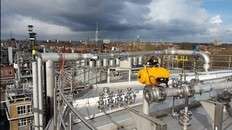- The project uses crude glycerine as feedstock for anaerobic digestion to produce biogas.
- The process reduces greenhouse gas emissions by 25%, equivalent to 12,000 tonnes CO2/year.
- Key chemicals involved include phosphoric acid, caustic soda, and glycerine.
- A new 2000kWe gas engine and modifications to the high-pressure steam boiler were implemented.

Project Overview
The QUARTERBACK for LIFE project aims to mitigate the environmental impact of crude glycerine production in the oleochemical industry. It demonstrates the technical and economic feasibility of using crude glycerine as the sole feedstock for an anaerobic digestion process to produce biogas, reducing greenhouse gas emissions by 25% (12,000 tonnes CO2/year).
Technical Details
The anaerobic glycerine digestion plant replaces a multistage concentration plant. The 10-15% glycerine mixture is pumped to a buffer tank, cooled to 37ºC, and charged into two mesophilic anaerobic digesters. Over 90% of the COD in the feed stream is converted to biogas, which is then processed and sent to a nearby boilerhouse/CHP area.
Process Enhancements
Various nutrients are added to sustain the biology in the digesters. An emergency flare is installed for surplus biogas. The digester outlet stream is degassed, separated from digestion sludge, and treated in an aerobic effluent treatment plant before discharge. A new 2000kWe gas engine converts biogas into electricity and heat, replacing low-pressure steam heating for storage tanks. The flue gas is treated to reduce nitrous oxides emissions and recover energy.
Boiler Modifications
The high-pressure steam boiler was modified to increase thermal efficiency by 10%. This involved replacing burners, adapting them for biogas, downsizing and relocating the main air fan, and installing a new control system using excess oxygen for air-to-fuel ratio control.

